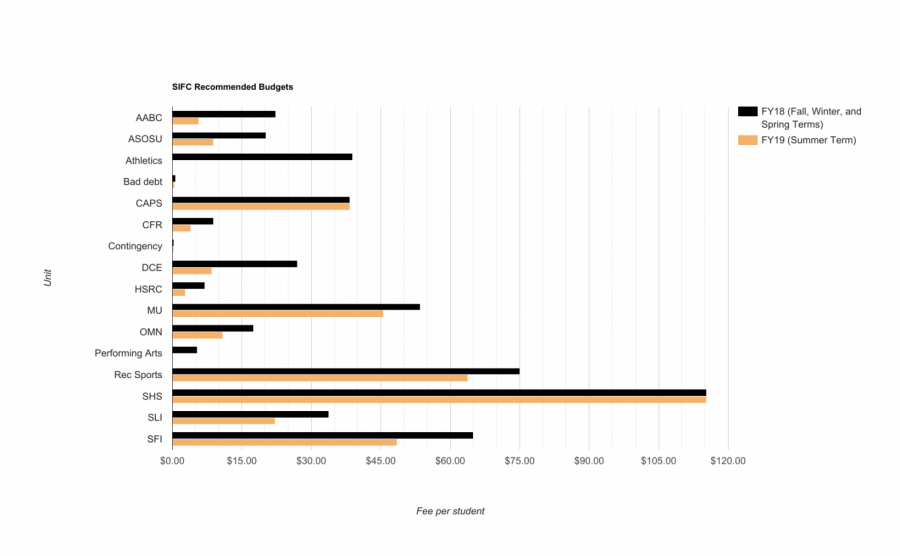SIFC recommends student fee levels to ASOSU Congress
February 12, 2017
The Student Incidental Fees Committee voted Sunday night to pass on their final student fee level recommendations for next year to the ASOSU Joint Congress.
| Unit | FY18 (Fall, Winter, and Spring Terms) | FY19 (Summer Term) |
| AABC | $22.26 | $5.75 |
| ASOSU | $20.21 | $8.85 |
| Athletics | $38.86 | $0.00 |
| Bad debt | $0.75 | $0.50 |
| CAPS | $38.37 | $38.37 |
| CFR | $8.91 | $4.00 |
| Contingency | $0.25 | $0.25 |
| DCE | $26.98 | $8.58 |
| HSRC | $6.99 | $2.75 |
| MU | $53.55 | $45.52 |
| OMN | $17.52 | $10.89 |
| Performing Arts | $5.35 | $0.00 |
| Rec Sports | $75.00 | $63.75 |
| SHS | $115.35 | $115.35 |
| SLI | $33.80 | $22.23 |
| SFI | $65.00 | $48.50 |
The next step in the student fee setting process will take place on Feb. 22. The recommended student fee levels for the FY18 and summer FY19 will be voted on by the ASOSU Joint Congress, at which point they will then be sent to the ASOSU President’s desk for her final approval. Public comment will be taken at this hearing, but this will be the last chance for students to have their voices heard by the body that is voting on their fees.
“I think that we were really responsible in allocating fee increases,” said SIFC Chair Peter Schwartz. “Increasing the funding is only going to cause these investments (building and equipment reserves) to last longer and to serve the student body for longer.”
Following hours of deliberation among the committee and feedback from the board, the SIFC concluded their open hearing in the student-fee setting process with their final recommendations.
Many of the budgets were approved as presented by the SIFC. However, there was more than one budget that did not receive approval for its entire ask. The performing arts budget was one such example. The committee spent over an hour deliberating before deciding to not approve all that the performing arts unit was asking for. Orange Media Network’s budget also went through a lengthy discussion before being approved, similar to the MU’s proposed budget.
The SIFC, which is comprised of 13 students that represent the various student-fee funded units on campus, has been looking over and going through all unit’s budgets since fall term. Sunday’s meeting was the culmination of the SIFC’s role in the fee setting process.
Throughout the open budget hearings and the SIFC open hearing, those directly impacted by the proposed budgets have had the opportunity to have their voices heard, and public comment was taken at the open hearing as well.
ASOSU President Rachel Grisham was also in attendance at the open hearing and was pleased with the final recommendations.
“I think in the end the committee was able to make some decisions that were really financially responsible,” Grisham said. “I think that their recommendation came with quite a bit of education and knowledge and I was really happy to see that.”
The Student Fee Setting Process
- Last winter term, ASOSU members at-large were elected for this year
- ASOSU President Rachel Grisham reached out to each student fee-funded organization for them to appoint a liaison to the SIFC
- Each of the program’s boards determined their base budgets (to maintain their current service levels) and any decision packages (added programs or services)
- These budgets were presented to the SIFC by representatives of the programs on Feb. 4-5
- Decision packages were examined in detail on Feb. 9
- SIFC evaluated the proposals and makes a recommendation to ASOSU on Feb. 12
- Joint session of the ASOSU House and Senate will deliberate and pass or not pass the budgets (Feb. 22)
- Final student approval comes from ASOSU President Rachel Grisham
If the budget is approved, it goes to the Office of Budget and Fiscal Planning, the OSU Board of Trustees and university president Ed Ray.
If it’s not approved, it goes to mediation. A committee composed of half SIFC members and half ASOSU representatives and senators will determine what the student fee will be. Back to Speaker of the House and VP, then on to the university administration.


















































































![Newspaper clipping from February 25, 1970 in the Daily Barometer showing an article written by Bob Allen, past Barometer Editor. This article was written to spotlight both the student body’s lack of participation with student government at the time in conjunction with their class representatives response. [It’s important to note ASOSU was not structured identically to today’s standards, likely having a president on behalf of each class work together as one entity as opposed to one president representing all classes.]](https://dailybaro.orangemedianetwork.com/wp-content/uploads/2025/03/Screenshot-2025-03-12-1.00.42-PM-e1741811160853.png)
























